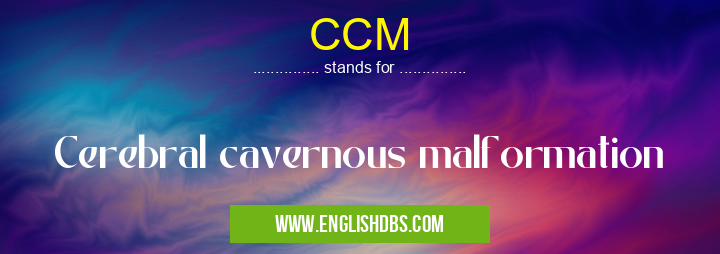What does CCM mean in HOSPITALS
Cerebral cavernous malformations (CCM) are clusters of abnormal blood vessels in the brain. They are known to occur in families and may be associated with certain genetic mutations, but the exact cause is not yet understood. CCM can cause seizures, headaches, and even stroke-like symptoms if left untreated. Therefore, it’s important to understand what this condition is and how it can be managed.

CCM meaning in Hospitals in Medical
CCM mostly used in an acronym Hospitals in Category Medical that means Cerebral cavernous malformation
Shorthand: CCM,
Full Form: Cerebral cavernous malformation
For more information of "Cerebral cavernous malformation", see the section below.
Definition of CCM
Cerebral Cavernous Malformation (CCM), also known as cavernous angioma or cavernoma, is an abnormality of the blood vessels in the brain. It consists of a cluster of dilated capillaries that form a tumor-like structure within the brain tissue. The abnormally thin walls of these vessels allow large amounts of blood to leak into surrounding tissues leading to disruption and compression of normal brain cells and nearby structures. The exact cause of CCMs is unknown; however, some cases are caused by inherited genetic mutations while others develop spontaneously without any family history. In addition, women are at greater risk for developing familial forms due to certain genetic predispositions that increase their risk for developing this disorder.
Symptoms of CCMs
Patients with Cerebral Cavernous Malformations often experience chronic headaches along with focal neurological deficits such as weakness or numbness on one side of the body depending on which area is affected by the malformation(s). Seizures may also occur if the malformation(s) is large enough to compress or disrupt localized tissue within the brain causing electrical abnormalities in nerve conduction. Lastly, patients may experience stroke-like symptoms if a CCM ruptures leading to an intracerebral hemorrhage.
Diagnosis & Treatment for CCMs
Cerebral Cavernous Malformations can be diagnosed with either a CT Scan or MRI Scan depending on complexity and size of lesion seen on imaging study. If a small number of lesions are present then typically treatment will involve surgical intervention where surgeons remove each lesion individually using microsurgery techniques such as endoscopy or stereotactic radiosurgery (gamma knife radiation). Medication such as anticonvulsants may also be prescribed if seizures are present or suspected to help reduce seizure activity associated with this disorder.
Essential Questions and Answers on Cerebral cavernous malformation in "MEDICAL»HOSP"
What is Cerebral Cavernous Malformation (CCM)?
Cerebral Cavernous Malformation (CCM) is a genetic disorder that affects the walls of small blood vessels in the brain. It causes clusters of abnormally enlarged capillaries and vessels that are prone to leak blood, resulting in a variety of neurological symptoms.
How common is CCM?
CCM is relatively uncommon, affecting somewhere between 1 in 200-500 individuals worldwide.
What are the symptoms of CCM?
Common symptoms associated with CCM include headaches, seizures, motor deficits such as weakness or numbness, visual disturbances, speech impairments and cognitive dysfunction. In some cases no symptoms may be present.
Is CCM hereditary?
Yes, in most cases it is inherited through an autosomal dominant gene mutation. The mutated gene can be passed from parent to child or may arise spontaneously due to genetic mutations during embryonic development.
How is CCM diagnosed?
Diagnosis typically involves imaging studies such as MRI or CT scans which can identify lesions in the brain caused by CCM. Genetic testing can also be used to confirm diagnosis and determine if family members have inherited the condition.
Can CCM be treated?
Yes, though there is no cure for CCM it can often be managed with medications and/or surgical interventions depending on the severity of the case. Radiation therapy may also help reduce risk of hemorrhage associated with CCM by decreasing size of affected lesions over time.
What kind of care should people living with CCM receive?
People living with CCM should have regular checkups with a neurologist and may benefit from a team approach involving medical specialists along with physical therapists, occupational therapists and psychologists who can support patient education and lifestyle management strategies that improve quality of life.
Final Words:
Cerebral Cavernous Malformations (CCMs) are clusters of abnormally thinned walls within blood vessels located within the brain that can lead to various neurological problems including seizures and stroke-like symptoms if left untreated. Understanding what this condition entails is key when diagnosing and treating it appropriately so that patients can lead healthy lives free from debilitating complications associated with cerebral cavernous malformations.
CCM also stands for: |
|
| All stands for CCM |
